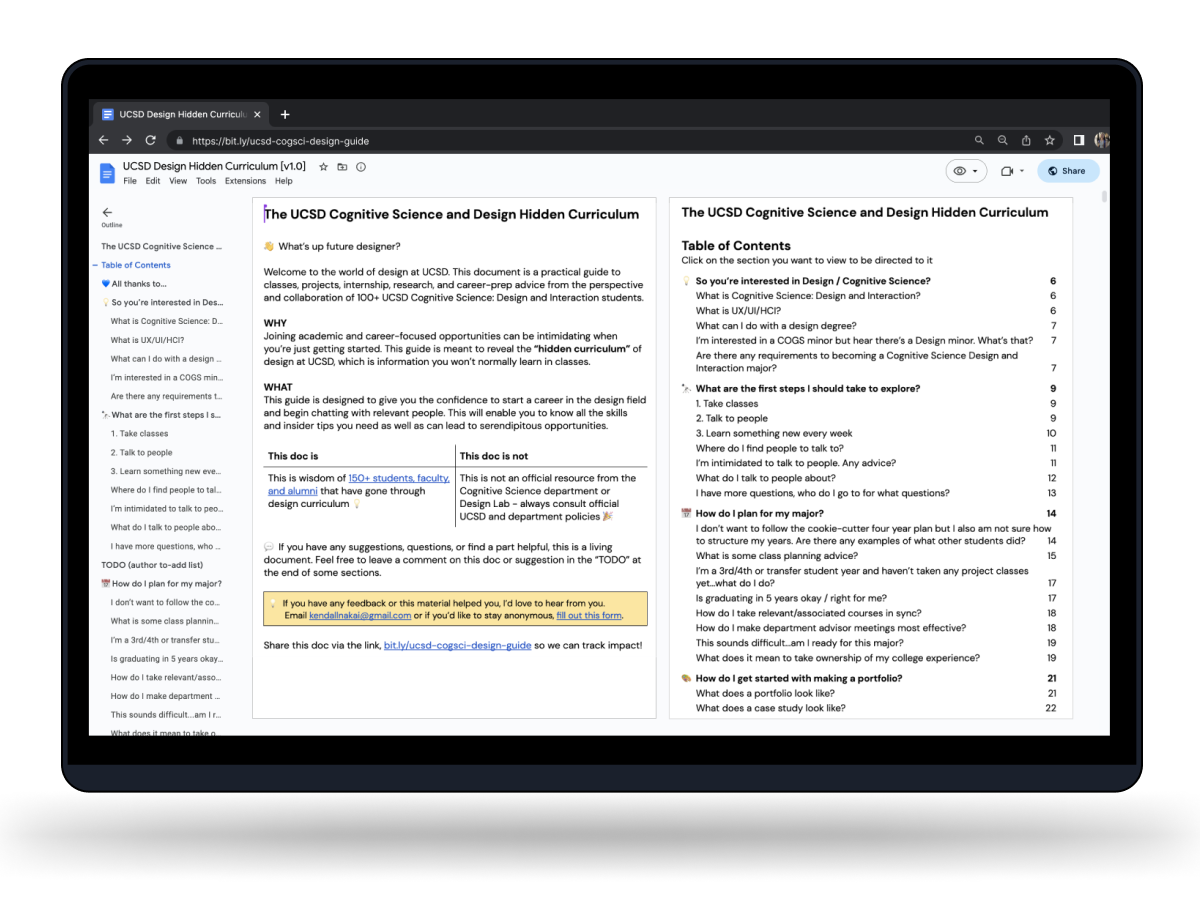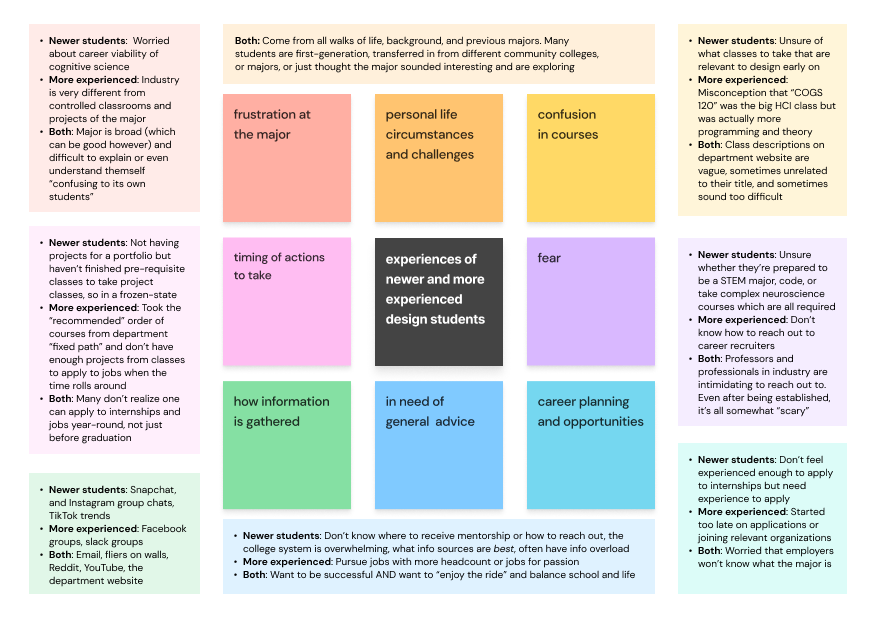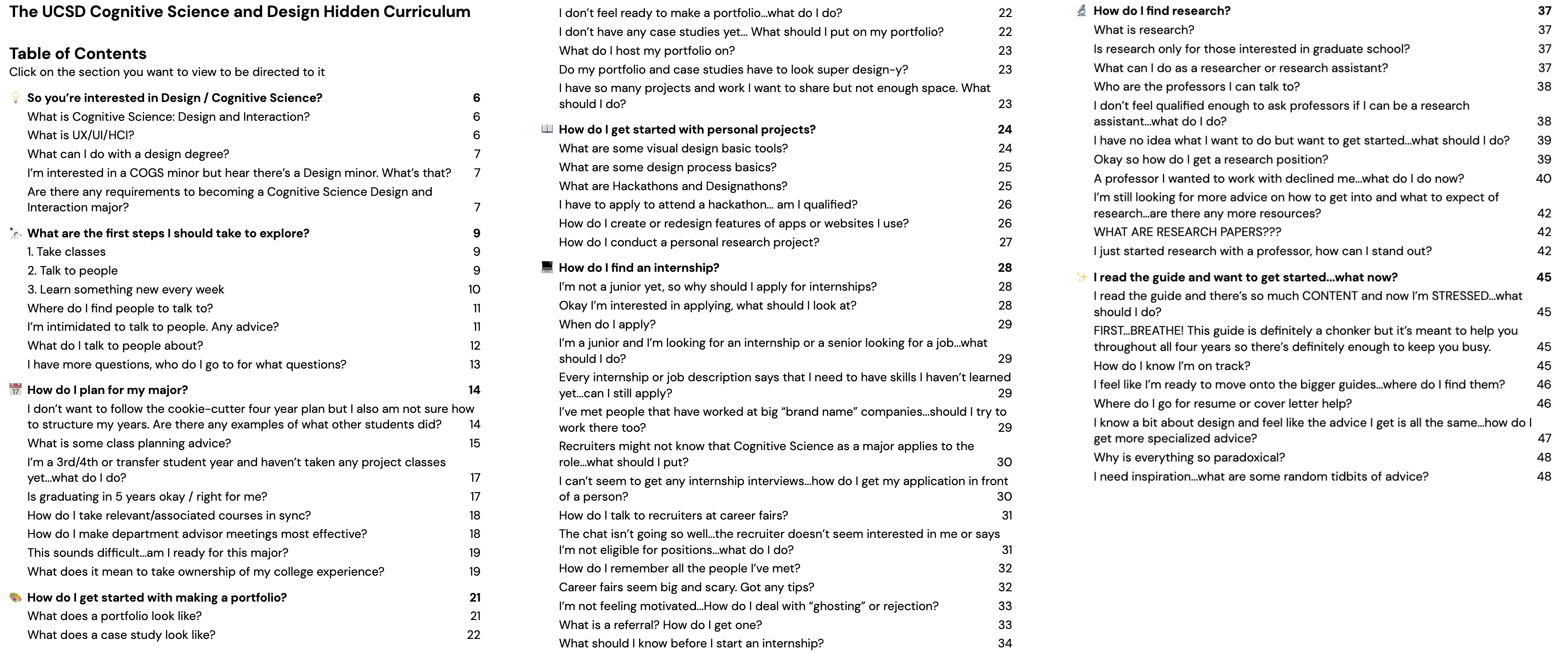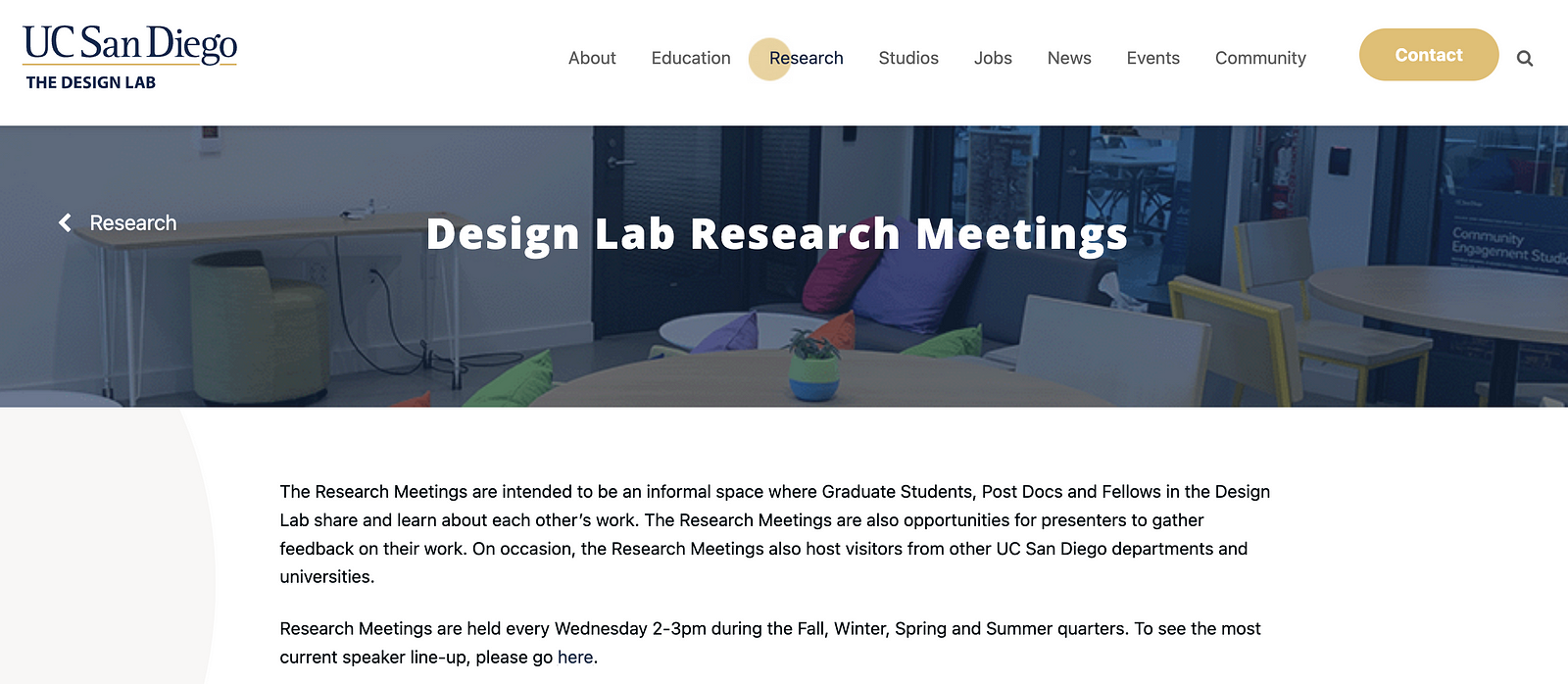Designing the UC San Diego Design Hidden Curriculum
My process in creating a 50 page guide for design students viewed 2700+ times over the past 2 years
The hidden curriculum is the unwritten rules, unspoken norms, and field-specific insider knowledge that are essential for student success but are not taught in classes.
This information often learned from mentors but many students like those who are underrepresented, first-generation, or from underprivileged backgrounds lack access to relevant resources.
I witnessed numerous peers face uncertainty, frustration, and lack of knowledge to start their journey through the hurdles and nuances of the design major and career.

I wanted to make the hidden curriculum less hidden.
I knew I wanted to something that would help students but wasn't sure exactly what yet. So I started out with what my experience was then reflected on what the current new student experience was.
Getting in the mindset of a new student
As a 3rd year in the major, it had been awhile since I was at square one.
I conducted several empathy exercises to re-live the different aspect of planning for one's major such as:
- Channelled my personal frustrations and hot takes I had thought of over the years and the friction caused
- Attending career center advising hours and asking common questions I had as a new student
- Mind-mapping several experiences that lead me to my major

With these frames of what my takes were from when I was a new student to the present, I wanted to know what new and more experienced student journey was.
Gaining perspective: channel the wonders and worries of both new and more experienced students
I interviewed 28 students:
- 17 first and second years sampled from an entry-level major course
- 11 third year and beyond, transfer, and graduated sampled from upper-division specialized major courses
I believe it's important to add value to those I interview and listen to.
I framed the new student interviews as mentoring chats so I would be able to hear their wonders and worries.
I framed the older student ones as it as a reflection chat or things I would tell my younger self with a personal promise that their lived experiences would contribute to a guide that can help future students.
These some of the overall themes from students' experiences they relayed during the mentoring and reflection chats:

Problem statement
From here, I identified the problem statement
Cognitive Science Design and Interaction early-stage students at UC San Diego feel confused in understanding their major and career steps to take and later-stage students can feel behind
So the goal was to make the hidden curriculum less hidden
How can we reveal the hidden curriculum of the Design and Interaction Major by facilitating mentoring in an emotionally reassuring way with step-by-step scenarios so readers can come out with understanding of their major, questions answered, and actionable steps to take
Prototyping: The medium of delivery was important to the accessibility of the guide
A guide seemed like a good artifact to share with students to help them learn the hidden curriculum. Using the questions and concerns from new students and reflections and things more experienced students wished they had known, I filled in many parts.
Action: I went through iterations from low-fidelity flash cards with topics on the front and advice on the back to lofty ideas of interactive Figma cards or a website.

Discovery: In showing the prototypes to students as I was need-finding, I found it would be too confusing to make something playful and more useful to go with what was familiar.

Outcome: The medium all UC San Diego students use week-to-week is Google Docs. This 50 page guide was released in July 2021 and has been released for 2 years now with 2700+ views.

Design goals: Relatable language, style, and emotionally resonant content so students would feel confident to take their next steps
I wanted to use relatable language, style, and emotionally resonant parts so students would feel assured and more confident in progress while reading.
Relatable language: I used a conversational tone that addresses readers like a peer rather than sounding like an authority figure. For instance, using colloquial language like all-caps and multiple punctuation marks (i.e. "WHAT ARE RESEARCH PAPERS???") can convey relatable feelings of confusion. To give more of an authentic voice, I used actual questions from students as section titles.

Easy to read style: Stylistically, I split long paragraphs of text into more easily skimmable two-column tables such as:
- Advice → Reason/Example
- Instead of [this] → Say [that]
Actionable steps and guided prompts: After going to too many career events with general advice and no idea what to do with it I wanted to give specific steps and prompts for students to be able to use.

Emotionally resonant content: I prioritized making the guide into something that would resonate with students on an emotional level so that it feels like a fellow classmate talking to them which included reassurance and different perspectives so students wouldn't be caught in a frozen state of fear which would inhibit their ability to make progress.

Ensuring the guide fits the needs of the students by having students of a design course review
To test the guide, I had 120 students from an entry to design upper-division course review it. It was recommended to give 3 constructive comments but ended up receiving 436 comments of critique, topic suggestions, and praise. It felt like a good sign that students already felt invested.
I replied to every comment to ensure they were acknowledged and appreciated and added or filled in with quantity many sections that were originally missed from qualitative chats (interviews).
I love that [it] provides encouragement for incoming students! It can alleviate a lot of concerns and reservations they have when deciding whether or not to pursue this path
like this section [about first steps to take], it's very informative. As no one had personally told me about this, I just had to muddle through!
Review and promote with relevant professors for equity of distribution
While many students read different forms of material, from Facebook, Reddit, TikTok, fliers, and more, from experience, the way to most equitably publicize this guide was through intro courses since all students must take them and have less chance of being filtered out through different medias that could be for those in the know.
For instance, a single example of information inequity at the time (2020) was the Class of 2022 Facebook group which I was in only had ~6000 members at the time (2020), but with ~9000 students in each undergraduate class, that's 3000 students potentially being missed. In the same thread, the UCSD Design Community Facebook group for all current and previous students has ~2900 members but the specific major itself has ~5000 students overall at any given time.
I took the hidden curriculum guide to one of the faculty meetings of design professors to get their perspectives as well as to request them to promote the guide in their own classes. Additionally, at the beginning of each quarter after release, I prompted professors to distribute the guide.
Coming from the place of an undergraduate and bringing them all these perspectives was eye-opening and conversation starting for professors as well. Topics of power, gender, race, as well as personalities of different professors verses students were brought up and were a good addition for the guide as well as reflection for faculty.

1.5 years later: Retrospective and re-interview
A year and half after the guide was released, it had been viewed >2000 times and distributed in several undergraduate courses at my college. However, I wanted to know how it had actually impacted students.
I surveyed 112 students from a new iteration of the the entry level upper division design course. Some students had seen the guide before and others hadn't. Because the guide specifically mentioned, validated, and provided solutions to common difficulties students had faced while maintaining a casual, uplifting narrative, I was interested to know if students felt the impact of it's design. Here were some of the results:

Students who read the guide spoke about how it impacted them:
[This] guide helped me fight with imposter syndrome. There were pieces of information for dealing with stress and burnout that can be applied to anything.
I realized everyone on the path has the same pressure as me, so normalizing the pressure helps me to be more productive and motivated.
I had access to this hidden curriculum [guide] very early on in my first year.5 It was the first form that bolstered my confidence to apply to different design organizations and gave me the motivation to kickstart my career journey. When I first read it, I felt a bit overwhelmed because there seemed like a lot ahead of me that I needed to accomplish. After reading through it, I had the motivation to apply to organizations like [student organization names] which all turned out well for me.
The full guide can be read at: bit.ly/ucsd-cogsci-design-guide
Making it scalable
A lot of comments I got from professors and students that were in other departments were "I wish this guide was made for my major" or "I think this kind of guide could be made for my department."
A year after the guide was released, my research advisor and I came up with a methodology to create similar hidden curriculum mentoring guides with the hopes other departments and schools will be able to create similar guides to help students.
I will be presenting it as a conference research paper at the ACM Conference on International Computing Education Research (ICER) in Chicago this Summer 2023 and presented it as a work-in-progress paper and poster at the ACM Conference on Learning at Scale (L@S) in New York in 2022.
